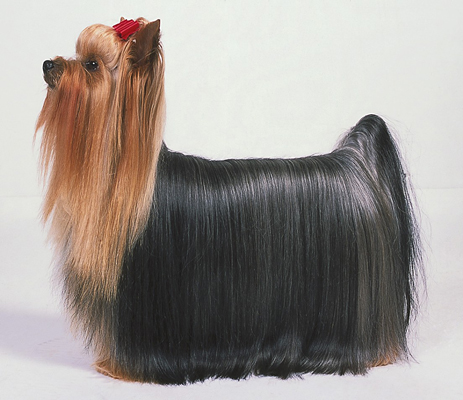Riconoscere le comuni lesioni da iguana
Un
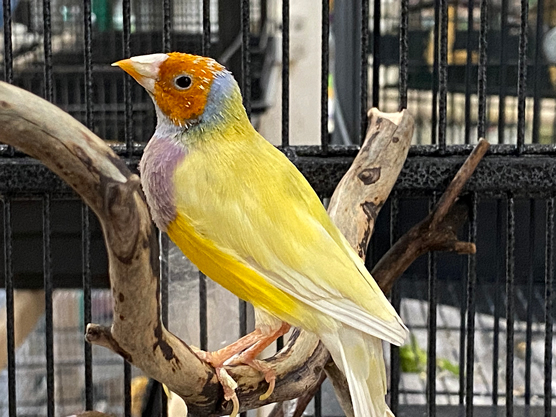
Canarini e Fringuelli
Fotografia per gentile concessione di Claudia Hunka, Your Basic Bird (Berkeley, California)
I canarini sono in realtà fringuelli, quindi li abbiamo combinati qui. Il canarino, tra gli uccelli da compagnia più antichi, popolari e vari al mondo, è noto per le sue doti vocali e per i suoi colori vivaci. Le Canarie sono originarie delle Isole Canarie, che non sono state nominate per i loro abitanti più famosi, ma per i cani che i romani trovavano lì. (Canis è latino per "cane".)
I canarini selvatici sono verdi e gialli, ma quando la gente pensa a loro oggi, molto spesso evocano un uccello giallo dai colori brillanti, grazie, soprattutto, al personaggio dei cartoni animati più furbo di Silvestro, Titti.
In effetti, i canarini sono disponibili in molti colori e varietà, grazie a secoli di allevamento selettivo. I canarini possono essere eleganti o paffuti nel tipo di corpo, lisci o gonfi quando si tratta di piume, con colori dal giallo all'arancione brillante al verde e al marrone. Se vuoi un cantante, però, assicurati che il tuo nuovo uccello sia un maschio; le canarie non cantano.
Sebbene sia ancora uno degli uccelli più popolari al mondo, del canarino non si parla tanto per il suo potenziale animale domestico come in passato. Ed è un peccato, perché l'uccello è perfetto per i principianti che non sono sicuri di volere tutta l'interazione richiesta da altre specie. Il canarino è felice di uscire in gabbia e intrattenerti con la bellezza e il canto. In effetti, preferirebbe non essere maneggiato.
Poiché non richiedono o non desiderano essere maneggiati, il canarino può essere un buon animale domestico per i bambini, fornendo canti e bellezza e consentendo ai giovani di osservare da vicino la meraviglia degli uccelli.
Anche i fringuelli, piccoli incantatori che incarnano la parola vivace, sono per lo più uccelli senza mani. I fringuelli sono appariscenti, veloci e divertenti da guardare, con un cinguettio vivace e costante che è notevolmente al di sotto del livello di decibel che i pappagalli sono in grado di raggiungere. Diverse specie di fringuelli sono disponibili come animali domestici, ma per i principianti, i più facilmente disponibili sono il diamante mandarino e il fringuello della società.
I fringuelli di Gould (nella foto), noti anche come Lady Gouldians o fringuelli arcobaleno, sono molto ammirati per il loro piumaggio dai colori vivaci.
La zebra (chiamata così per le strisce, specialmente sulla coda e sul muso) è un nativo australiano che è disponibile in molte varietà distintive che differiscono nel colore, più varietà di quelle che puoi trovare in qualsiasi altra specie di fringuelli. E chiunque può distinguere le ragazze dai ragazzi quando si tratta delle comuni zebre grigie: i ragazzi hanno guance arancioni brillanti e fianchi arancioni scuri, e le ragazze no.
I fringuelli della società sono una creazione umana, una delle poche specie di uccelli domestici che non sono mai esistite in natura. Chiamato anche fringuello bengalese, la società è disponibile in molti colori e modelli ed è un custode facile che si trova a suo agio nell'ambiente umano, come ci si può aspettare da una specie completamente addomesticata.
I fringuelli si comportano meglio in una situazione sociale, quindi pianifica di acquistarne due o più e di dare loro una gabbia con molto spazio per esercitare le loro ali. Questi uccelli si muovono volando e, a differenza dei pappagalli, non si arrampicano per fare esercizio.
Poiché sono perfettamente contenti di vivere senza manipolazione, i fringuelli sono un eccellente uccello da voliera. Sono sempre un piacere osservarli. Per questo motivo, il fringuello va bene anche per un uccello in gabbia nella stanza di un bambino più grande.
Poiché i fringuelli sono piccoli, alcune persone credono di non aver bisogno di molto in termini di dimensioni della gabbia, e questo è sbagliato. I fringuelli hanno bisogno di spazio per volare e, quando sono alloggiati con altri della loro specie, hanno bisogno di spazio sufficiente per avere un po' di territorio da chiamare proprio. Hanno bisogno di spazio e sottospazi sufficienti nei loro alloggi per poter scegliere di essere visti o meno. Quando sono troppo affollati, le battaglie territoriali tra compagni di gabbia sono comuni.
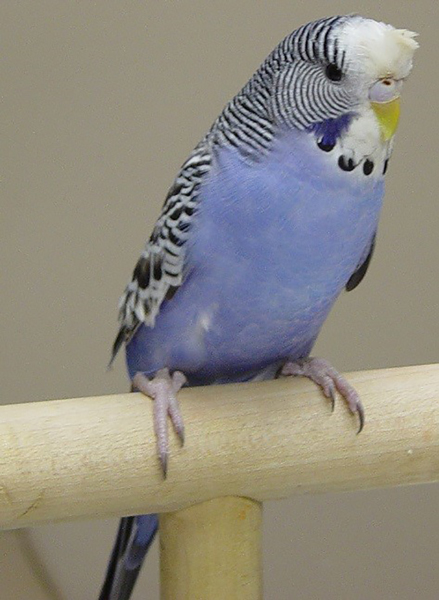
Parrocchetti (parrocchetti)
Fotografia di Brian L. Speer, DVM
Finalmente un uccellino in mano! A causa del loro basso prezzo e della facile disponibilità, i pappagallini (comunemente conosciuti negli Stati Uniti come parrocchetti) sono spesso trattati come uccelli usa e getta: facilmente acquistabili, facilmente smaltibili, facilmente sostituibili. Questo atteggiamento deplorevole impedisce alle persone di valutare questi uccelli per la loro personalità affettuosa. Alcuni pappagallini diventano anche ottimi chiacchieroni, anche se con vocine minuscole.
Il nome pappagallino deriva dagli umani nativi dell'Australia, gli aborigeni. Quattro sillabe sono un boccone, motivo per cui alcune persone hanno iniziato a chiamare questi uccelli dai colori vivaci "parrocchetti". Anche se il nome non è sbagliato, è impreciso. Tutti i pappagallini sono parrocchetti, ma non tutti i parrocchetti sono pappagallini. Esistono molte specie di parrocchetti e molti di loro sono disponibili come animali domestici, tra cui il Quaker, le guance grigie, il collo ad anello e le ali di canarino, solo per citarne alcuni.
I pappagallini (come quello mostrato) si trovano comunemente in due varietà principali, differenziate per tipo di corpo: l'americano stretto e l'inglese più huskier. I colori ora vanno ben oltre il verde o il blu di decenni fa. Poiché questi uccelli sono venduti così a buon mercato (soprattutto l'americano), l'allevamento di mani non paga, quindi pochi allevatori investono tempo o problemi. I pappagallini possono essere addomesticati con un trattamento gentile e paziente e possono legarsi strettamente ai loro compagni umani. Altri sono più adatti alla vita da uccelli da gabbia e preferiscono non essere maneggiati.
Vale la pena cercare i pappagallini allevati a mano per il loro eccellente potenziale da compagnia.
Per un bambino abbastanza grande da comprendere la necessità di un trattamento delicato e rispettoso, i pappagallini sono animali domestici ideali. Ma non lasciare che la loro reputazione di ottimo animale domestico per bambini ti impedisca di considerarlo come un compagno per un adulto. Questi uccelli attivi, amorevoli e divertenti sono facili da allevare e relativamente silenziosi.
Trattare con una buona fonte è importante quando si acquista un uccello domestico, ma trovare un venditore affidabile è ancora più importante con i pappagallini. Gli uccelli prodotti in serie sono più difficili da domare perché non sono stati socializzati e potrebbero essere più inclini a problemi di salute potenzialmente letali.
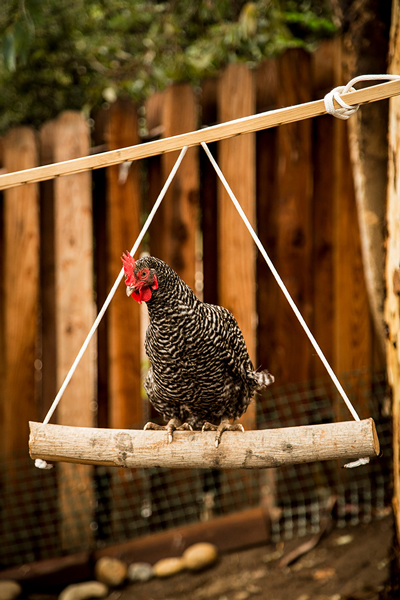
polli
Fotografia per gentile concessione di Elizabeth Anderson Lopez
One of the big surprises of the past 20 years has been the rise in popularity of chickens as pets. People no longer keep them simply for their ability to lay eggs; many people have discovered the joys of cuddling a chicken or teaching one tricks. Chickens (shown) are full of personality, inexpensive to purchase, and easy to keep in any environment, including small city spaces. Cute chicken diapers allow them to be house pets as well. Outdoors, they eat bugs in your yard and fertilize it with their droppings. Bonus: delicious fresh eggs!
Chickens come in a variety of sizes, colors, and patterns. You can choose chickens based on personality, type of plumage, or the color of the eggs they produce: blue, green, brown, olive, speckled, or classic white. Some that we recommend as great beginner birds include sweet and fluffy Buff Orpingtons, friendly Barred Rocks (once described as the Labradors of chickens), Rhode Island Reds for their hardiness, and Ameraucanas, with their pretty green eggs.
The color of the eggs a chicken produces is determined by genetics. Different types of chickens lay eggs of different colors. For instance, Barred Rocks and Rhode Island Reds lay brown eggs; Ameraucanas lay green eggs; Easter Eggers lay blue, green, and pink eggs; and Leghorns lay white eggs. All eggs start out white; pigment, if it’s going to be there, is deposited as the egg develops. Chickens with white earlobes usually produce white eggs.
Chickens
Photograph courtesy of Elizabeth Anderson Lopez
One of the big surprises of the past 20 years has been the rise in popularity of chickens as pets. People no longer keep them simply for their ability to lay eggs; many people have discovered the joys of cuddling a chicken or teaching one tricks. Chickens (shown) are full of personality, inexpensive to purchase, and easy to keep in any environment, including small city spaces. Cute chicken diapers allow them to be house pets as well. Outdoors, they eat bugs in your yard and fertilize it with their droppings. Bonus: delicious fresh eggs!
Chickens come in a variety of sizes, colors, and patterns. You can choose chickens based on personality, type of plumage, or the color of the eggs they produce: blue, green, brown, olive, speckled, or classic white. Some that we recommend as great beginner birds include sweet and fluffy Buff Orpingtons, friendly Barred Rocks (once described as the Labradors of chickens), Rhode Island Reds for their hardiness, and Ameraucanas, with their pretty green eggs.
The color of the eggs a chicken produces is determined by genetics. Different types of chickens lay eggs of different colors. For instance, Barred Rocks and Rhode Island Reds lay brown eggs; Ameraucanas lay green eggs; Easter Eggers lay blue, green, and pink eggs; and Leghorns lay white eggs. All eggs start out white; pigment, if it’s going to be there, is deposited as the egg develops. Chickens with white earlobes usually produce white eggs.
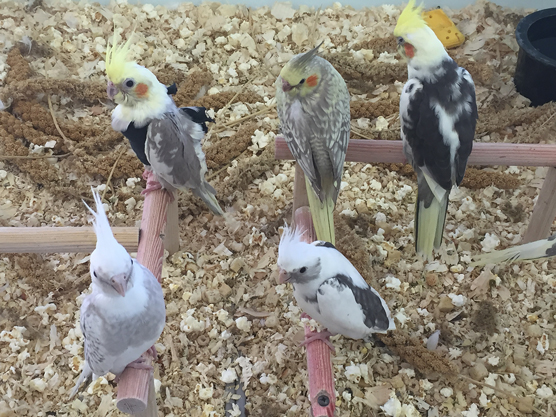
Cockatiels
Photograph by Kim Campbell Thornton
Cockatiels (shown) are exceptionally popular, and justifiably so. These small parrots are flat-out loving, and they live to snuggle and be petted. If you only recognize the gray bird with orange patches, you may be surprised at how many colors are available these days, thanks to the work of some highly energetic aviculturists.
Some cockatiels learn to talk, but many, particularly the males, are better at whistling. This bird is another who can be a good choice for children, as long as the kids understand the need for careful handling.
Cockatiels can become whatever you make them. When you give one plenty of love and interaction, you can expect to come up with a real winner.
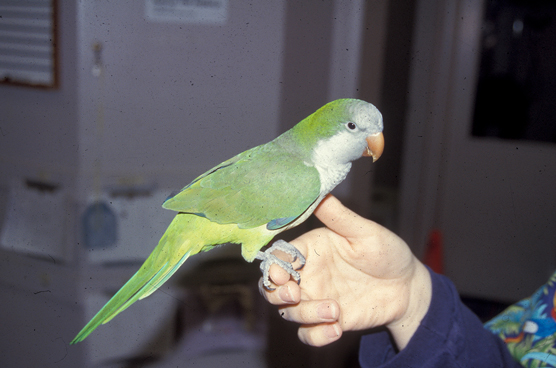
Quaker parakeets
Photograph by Brian L. Speer, DVM
The Quaker (shown) didn’t acquire its name from any religious leanings. The bird is thought to have earned the descriptive title through one of the common noises it makes or the quivering of its youngsters when they beg for food.
Green with a silvery front, Quakers are active and upbeat, and they like to vocalize. Some learn to talk, while others love to whistle. All can be loving if socialized when young and given consistent, respectful handling.
We have to admit to little hands-on experience with Quaker parakeets, but the lack of acquaintance isn’t because we don’t like them. They’re illegal in California, where we live, because they’re considered a threat to native species and agribusiness because of their ability to adapt to a wild lifestyle. Although we can’t really say we agree with the policy, we can say the Quaker is well worth considering if you live in places where they’re legal.
Other states in the United States that ban them include Connecticut, Georgia, Hawaii, Kentucky, Pennsylvania, Rhode Island, Tennessee, and Wyoming. A few other states regulate them in one way or another. For information on the latest restrictions where you live, check with your state’s Department of Agriculture or fish and game authorities.
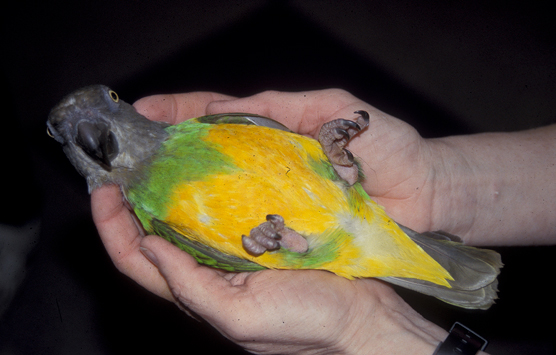
Poicephalus parrots
Photograph by Brian L. Speer, DVM
The small African parrots known collectively as Poicephalus are an easygoing bunch. Of the species available as pets, Senegals (like the one shown) are probably the most common; they’re handsome little birds with a gray head, green back and wings, and yellow-orange underside. Other species in the group include the Meyer’s, Jardine, cape, red-belly, and brown-head — all known for their small size (a little bigger than a cockatiel) and affectionate personalities. They aren’t the best talkers, but some manage verbalization quite well. Their noise level isn’t too bad.
Poicephalus can be devoted to their owners, and after they decide you’re trustworthy, they’re especially fond of having their heads and necks scratched — in fact, they beg for it, tipping their heads and leaning over to expose their necks for a good scratch.
Poicephalus parrots
Photograph by Brian L. Speer, DVM
The small African parrots known collectively as Poicephalus are an easygoing bunch. Of the species available as pets, Senegals (like the one shown) are probably the most common; they’re handsome little birds with a gray head, green back and wings, and yellow-orange underside. Other species in the group include the Meyer’s, Jardine, cape, red-belly, and brown-head — all known for their small size (a little bigger than a cockatiel) and affectionate personalities. They aren’t the best talkers, but some manage verbalization quite well. Their noise level isn’t too bad.
Poicephalus can be devoted to their owners, and after they decide you’re trustworthy, they’re especially fond of having their heads and necks scratched — in fact, they beg for it, tipping their heads and leaning over to expose their necks for a good scratch.
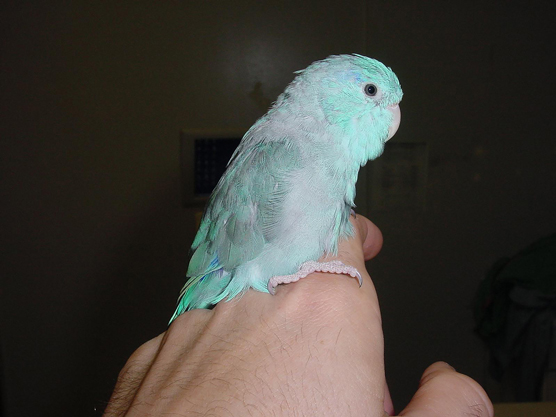
Parrotlets
Photograph by Brian L. Speer, DVM
An even smaller parrot to consider: the parrotlet (shown). Don’t let their small size fool you; these 5-inch dynamos are all parrot — active, inquisitive, loving, and demanding. Two varieties are commonly available as pets — the Pacific and the green-rumped — but more species are becoming increasingly available. Apple-green or blue in hue, parrotlets are quieter than some of their larger relatives, but some develop the gift of gab.
Another one to consider is a newer, less aggressive little bird on the block: the lineolated parakeet. Quiet and calm, they enjoy walking as much as flying and enjoy playing in water. Approximately the same size as a budgie or lovebird, these friendly and funny parakeets can learn to talk and whistle.
Some species are better talkers than others, picking up words, phrases, and household sounds with little or no effort on the part of their owners. Other species are able to mimic a few sounds if their owners work with them patiently.
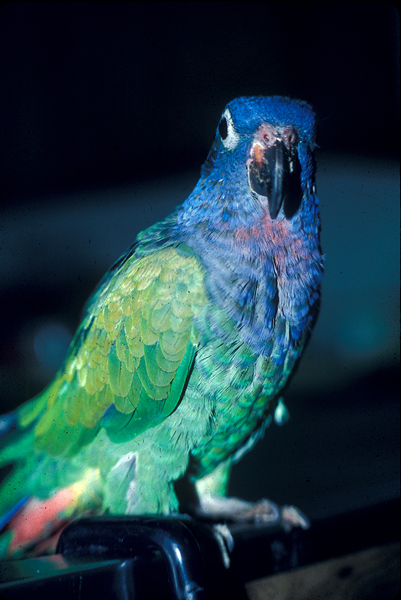
Pionus parrots
Photograph by Brian L. Speer, DVM
Pionus parrots are sometimes overlooked because they’re just not as flashy as other parrots — their beauty is more subtle. But what they lack in bright colors they make up for with winning personalities.
Several species of Pionus (shown) are available as pets, including Maximilian, blueheads, dusky, bronze-winged, and white-capped. Pionus are slightly larger than the Poicephalus, but they’re still small enough to be easy to keep and handle. Their personalities are considered among the more sedate, and they’re not excessively loud. (Nor are they considered fantastic talkers, although they’re certainly capable of learning a few phrases.) The word most connected with the Pionus is sweet, and it fits — socialized, well-handled birds are unparalleled as loving companions.
And when you’re in love with one, you can appreciate the subtle beauty of these birds — the plumage of a healthy Pionus has an almost iridescent quality about it.
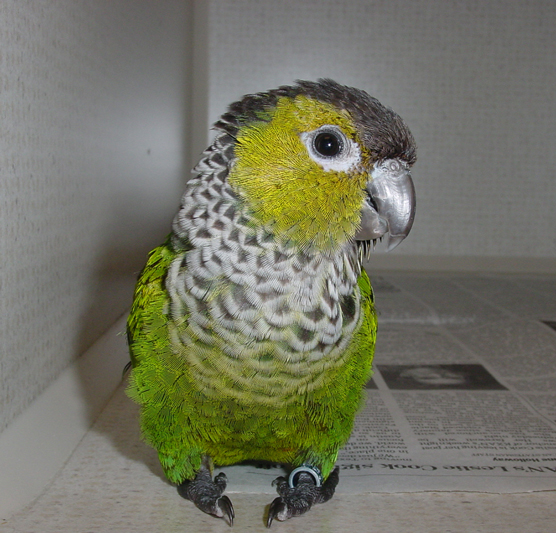
1
Pyrrhura conures
Photograph by Brian L. Speer, DVM
The conures (shown) are one of the larger groups of parrots, with more than 100 species and subspecies. As pets, conures are well-represented, too, with about a dozen available, including such well-known birds as the jenday, dusky, and sun. These three belong to the Aratinga genus, but our best-for-beginners picks belong to another category, the Pyrrhura genus. (Does it seem like we always choose the ones that are hard to spell and pronounce?)
If you find it easier, call them either green-cheeked or maroon-bellied, because these are the most commonly available species in the category. Whatever you call them, though, you can look forward to a lovely pet. Both species are much, much quieter than the sun conure (but then, so are some rock bands). Enthusiasts say the Pyrrhura is affectionate and playful. Colors aren’t as dramatic as the red-and-gold sun, but the greens of the lesser-known conures still make for an attractive companion. Some may even grace you with a few acquired phrases.
Although Aratinga conures such as the sun may not be the best choice for beginners, their colorful appearance and clownish personalities have won them plenty of fans — and a starring role in the movie Paulie. (Paulie was a blue-crowned conure.)
1
Pyrrhura conures
Photograph by Brian L. Speer, DVM
The conures (shown) are one of the larger groups of parrots, with more than 100 species and subspecies. As pets, conures are well-represented, too, with about a dozen available, including such well-known birds as the jenday, dusky, and sun. These three belong to the Aratinga genus, but our best-for-beginners picks belong to another category, the Pyrrhura genus. (Does it seem like we always choose the ones that are hard to spell and pronounce?)
Se lo trovi più facile, chiamali dalle guance verdi o dal ventre marrone, perché queste sono le specie più comunemente disponibili nella categoria. Comunque li chiami, puoi aspettarti un adorabile animale domestico. Entrambe le specie sono molto, molto più silenziose del conuro del sole (ma lo sono anche alcune band rock). Gli appassionati dicono che il Pyrrhura è affettuoso e giocherellone. I colori non sono così drammatici come il sole rosso e oro, ma i verdi dei conuri meno conosciuti sono comunque un compagno attraente. Alcuni potrebbero persino abbellirti con alcune frasi acquisite.
Sebbene i conuri di Aratinga come il sole potrebbero non essere la scelta migliore per i principianti, il loro aspetto colorato e le personalità clownesche hanno conquistato molti fan e un ruolo da protagonista nel film Paulie. (Paulie era un conuro dalla corona blu.)
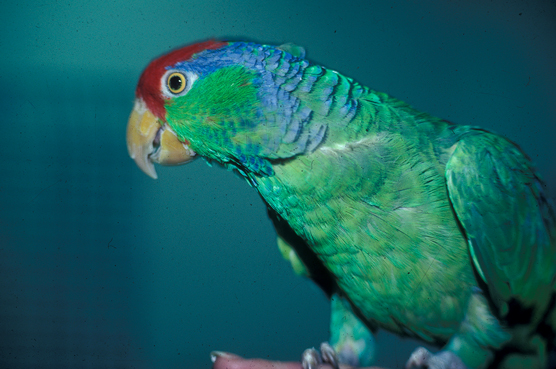
1
pappagalli amazzonici
Fotografia di Brian L. Speer, DVM
Le amazzoni (come quella mostrata) sono un po' più grandi e più costose di molti degli uccelli che descriviamo in questo articolo, ma sono troppo dannatamente attraenti per lasciarle fuori dalla lista. Le amazzoni sono tra le migliori chiacchiere in circolazione, in particolare le specie dalla nuca gialla. Anche le amazzoni sono belle e brillanti e adorano fare il pagliaccio. Quando Brian sente un uccellino che intrattiene se stessa e tutti quelli che la circondano nella sala d'attesa del suo ospedale, sa senza guardare che si tratta di un'amazzone. Amano essere sotto i riflettori e sembrano nutrirsi dell'attenzione che attirano.
Le amazzoni sono pappagalli di taglia media. Sono uccelli molto attivi che amano davvero passare il tempo con le persone che amano. Anche un'amazzone apprezza i suoi giocattoli ed è uno degli uccelli più facili da addestrare per eseguire determinati comportamenti.
Alcune specie amazzoniche sono più facili da vivere con altre. Per i principianti, raccomandiamo le corone lilla, la fronte blu, la fronte rossa e la fronte bianca. Queste specie più piccole hanno meno probabilità di spingere, sono generalmente più silenziose e sono facili da maneggiare.
Un potenziale problema per i principianti: le Amazzoni possono essere troppo intelligenti. Come con qualsiasi pappagallo, devi assicurarti di dare al tuo uccello molta socializzazione strutturata, una buona dose di giocattoli e molto esercizio.
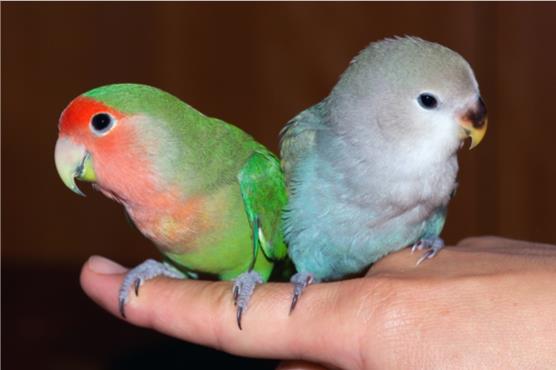
1
Piccioncini dalla faccia di pesca
Fotografia di Paul Atkinson/Getty Images
I piccioncini dalla faccia di pesca sono belli, attivi e giocosi. È possibile parlare, ma non è per questo che sono famosi questi piccoli pappagalli. Un viso di pesca ben socializzato può essere il tuo migliore amico per anni, se non lo lasci a marcire da solo in una gabbia. Quando vengono cresciuti a mano e socializzati con gli umani, questi piccoli ragazzi amano essere maneggiati, portati in giro nel taschino della camicia o sotto i capelli sul colletto. Sono molto affettuosi, non eccessivamente rumorosi e capaci di captare alcune frasi.
Le specie di piccioncini comunemente disponibili come animali domestici includono il Fischer, la maschera nera e la faccia di pesca, con l'ultimo che è il più popolare. I piccioncini dalla faccia di pesca sono disponibili anche in molte interessanti mutazioni di colore, tra cui Lutinos, olive e pieds.
Un
Scopri tutte le informazioni sul Carlino ideale, comprendendo le scelte da fare e le caratteristiche fisiche fondamentali, per portare a casa il cane perfetto per te.
Scopri i segreti della comunicazione delle iguane: postura, giogaia, movimenti e linguaggio corporeo. Guida completa per comprendere ogni sfumatura del loro comportamento.
Scopri le differenze chiave tra Rottweiler maschi e femmine. Confronto dettagliato su dimensioni, temperamento, addestramento e cure per aiutarti a scegliere il compagno perfetto.
Lo Yorkshire Terrier appartiene allAKC Toy Group per le sue dimensioni, ma ha il cuore e gli istinti di un vero Terrier. Scopri lo standard di razza e i dettagli indispensabili per i proprietari di Yorkie.
Scopri cosa fare se il tuo cane rimane impigliato con gli aculei di porcospino. Le informazioni utili per il benessere del tuo animale.
Scopri i problemi di salute comuni ai Jack Russell Terrier, tra cui cardiomiopatia e malattia di Von Willebrand. È fondamentale conoscere i sintomi e consultare un veterinario.
È ora di iniziare a organizzare tutte le foto del tuo cane! Lightroom ha alcuni strumenti organizzativi davvero fantastici, il cui punto cruciale è una piccola funzionalità chiamata Raccolte. Vedete, quando importi le foto in Lightroom, il software le aggiunge automaticamente al pannello Cartelle, attraverso il quale puoi navigare, proprio come navighi verso uno specifico […]
Man mano che il cucciolo matura e iniziano le lezioni, potresti voler passare da un collare o un'imbracatura di nylon a un collare di condizionamento o di addestramento, che scoraggia l'affondo, la trazione e la reattività generale e a un guinzaglio più robusto. Usa il rinforzo positivo per incoraggiare la concentrazione del tuo cucciolo. I collari condizionanti incoraggiano il tuo cucciolo a camminare vicino a te attraverso […]
A seconda delle attività esterne del tuo Jack Russell Terrier, dovresti lavarlo solo ogni mese o meno. Naturalmente, se il tuo terrier è fuori a rotolare nella terra ogni giorno, potresti doverlo bagnare un po' più frequentemente. I bagni brevi e più frequenti sono migliori di quelli lunghi e poco frequenti. Ottenere […]

